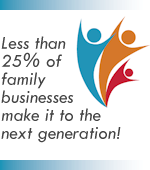![]()
Succession Strategies
Evolution of Millennials
It's finally happened: Millennials are taking over the country.
 According to an article published by USA Today on June 25, 2015, Millennials, or those born from 1982 through 2000, now make up more than one quarter of the U.S. population (83.1 million), exceeding the 75.4 million Baby Boomers who were born from 1946 through 1964, according to U.S. Census Bureau estimates released Thursday.
According to an article published by USA Today on June 25, 2015, Millennials, or those born from 1982 through 2000, now make up more than one quarter of the U.S. population (83.1 million), exceeding the 75.4 million Baby Boomers who were born from 1946 through 1964, according to U.S. Census Bureau estimates released Thursday.
They're also more diverse than any generation before them – 44.2% of American Millennials are part of a minority race or ethnic group, according to the estimates. In fact, the whole U.S. population is more racially and ethnically diverse. A total of 37.9% of Americans identified as minorities in 2014, up from 32.9% in 2004.
Another milestone: In 2014, those younger than 5 years old "became majority-minority for the first time, with 50.2% being part of a minority race or ethnic group," according to the estimates. "Majority-minority" refers to when less than half of a population are non-Hispanic, single-race Whites. The U.S. as a whole is expected to become majority-minority by 2044, according to another report from the Census Bureau
Succession from the Inside Out
Succession planning in a family business is often not a deliberate thing. As the emerging business needs or requirements present themselves such as failing health or death of the senior family business leader often dictates how the session occurs.
Very few family businesses plan for succession. They do not recognize the need for leadership development particularly when it comes to another family member. Often times family business leaders will judge the skills of non-family personal much more judiciously than that of family personnel. I know of many situations where family business leaders have been promoted into leadership roles without the kind of professional background which would be required for most other similar roles. They may succeed and even excel in this new role but it is a difficult journey.
Everyone on the team should be continually training their replacement! Yes that’s right, train the people around you just like they were going to replace you. You must direct this to ALL levels within your organization, from the mail room to the board room. This is particularly critical for a family business.

Succession Tips
Behaviors in Older Generation Leaders which Frustrate Younger Generation Leaders
- A scarcity mindset.
- A desire to control every aspect of the business.
- Ego-driven decisions.
- Negative legacy practices.
- Not listening.
- Only as good as their last conversation.
- Decisions based on social prejudices.
- Being too judgmental.
- Stuck in the past. Outdated thinking.
- Making exceptions to policies they themselves establish.
- Spending inordinate time and resources on pet-projects.
- Special treatment for particular employees.
- Resistance to embrace emerging technologies.
- Not behaving in a way in which they ask others to behave.
How well-equipped is the next generation in navigating your business through the challenges of the coming decades? Download our FREE Generational Planning Guide.